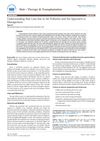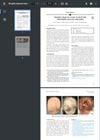TLDR ScalpEye accurately diagnoses scalp issues like dandruff and hair loss.
The study introduced ScalpEye, a deep learning-based system designed for inspecting and diagnosing scalp hair issues such as dandruff, folliculitis, hair loss, and oily hair. The system included a portable imaging microscope, a mobile app, and a cloud-based AI server and management platform. ScalpEye utilized the Faster R-CNN with the Inception ResNet_v2_Atrous model for image recognition, achieving an average precision between 97.41% and 99.09% in diagnosing the four common scalp symptoms. This system aimed to enhance scalp healthcare by providing efficient and accurate diagnoses.
 69 citations
,
January 2015 in “Current problems in dermatology”
69 citations
,
January 2015 in “Current problems in dermatology” Trichoscopy is a quick, noninvasive method to diagnose hair and scalp disorders, often reducing the need for biopsies.
 7 citations
,
January 2015 in “Hair therapy & transplantation”
7 citations
,
January 2015 in “Hair therapy & transplantation” Air pollution can cause hair loss, and using antioxidants, special shampoos, and coconut oil can improve scalp health and hair density.
 86 citations
,
October 2013 in “Dermatologic Clinics”
86 citations
,
October 2013 in “Dermatologic Clinics” Trichoscopy is a useful non-invasive method for diagnosing different hair loss conditions.
 1 citations
,
August 2022 in “JAAD case reports”
1 citations
,
August 2022 in “JAAD case reports” Tofacitinib and oral minoxidil may help treat Sisaipho alopecia areata.
7 citations
,
January 2021 in “Journal of Cosmetics Dermatological Sciences and Applications” Improving the scalp's barrier function can help reduce dandruff and maintain scalp health.
3 citations
,
August 2020 in “Journal of cosmetic dermatology” The scalp care solution with Timosaponin B-II improved scalp hydration, reduced dandruff, and helped prevent hair loss.
 January 2017 in “Journal of Cosmetics, Dermatological Sciences and Applications”
January 2017 in “Journal of Cosmetics, Dermatological Sciences and Applications” Chinese women's hair gets thinner and grayer with age, and scalp conditions change, especially after 40.





